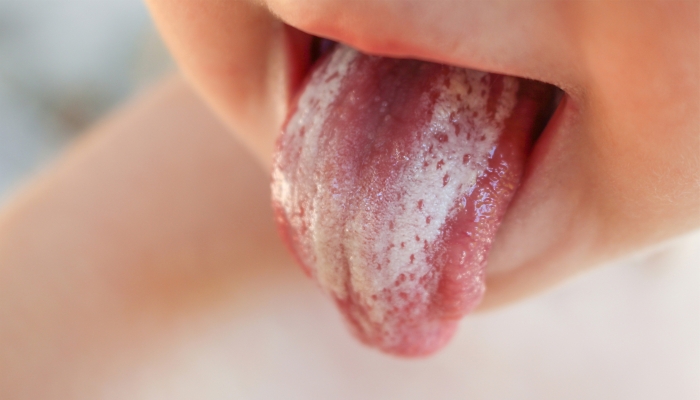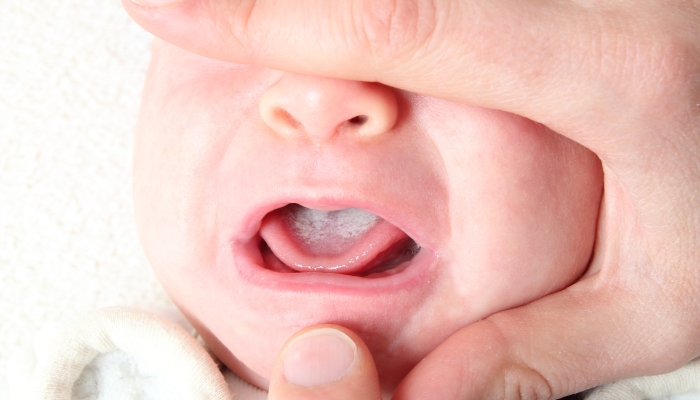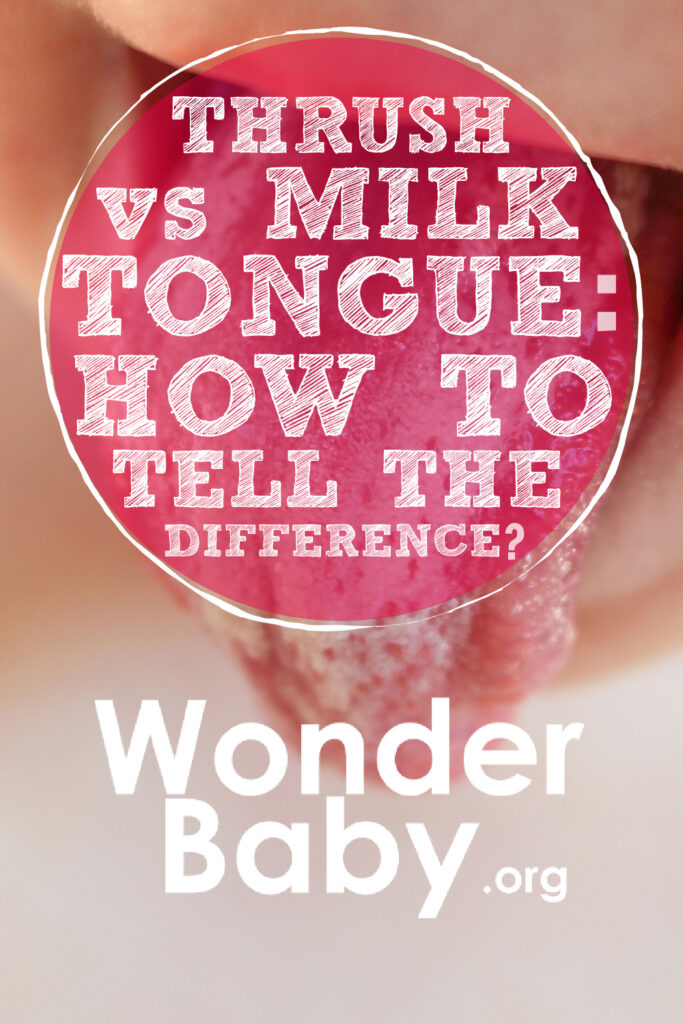Thrush vs Milk Tongue: How to Tell the Difference

- Milk tongue is common and is caused by milk residue left on your baby’s tongue.
- Oral thrush is caused by a fungal infection
- Milk tongue is only found on your baby’s tongue and wipes off easily.
- Thrush causes white patches throughout the entire mouth.
If you notice white residue or white patches in your child’s mouth, you’re probably going to be looking at one of two things. Your child may have some leftover milk on their tongue, or they may be experiencing oral thrush.
Milk residue probably doesn’t have you too worried, but the thought of something called thrush on their tongue might have you a little concerned. Both are pretty common but are caused by totally different things. Knowing the basics of what causes each and how they look different is the best way to differentiate thrush vs. milk tongue.
Why Is My Baby’s Tongue White?
If you’ve noticed your baby has a white tongue, let’s immediately start by putting your mind at ease. A white tongue in babies is pretty common and is not a sign of anything dangerous.
Your baby’s white tongue may be from something called milk tongue. Milk tongue is pretty much what it sounds like. When there is a build-up of milk on the baby’s tongue, it can turn the baby’s tongue white. Sometimes because of the anatomy or shape of the baby’s mouth, there isn’t enough friction to scrape the milk off.
However, a white tongue may also be a case of oral thrush. This is an actual medical condition, but it’s not dangerous. Thrush can be easily managed by working with your child’s doctor.
Thrush vs Milk Tongue in Babies: What You Need To Know

The most common reason for a baby to have a white tongue before they’ve started solid foods is because of milk residue. A newborn baby’s main source of nutrition is milk or formula, so it’s not at all surprising to see some milk residue hanging out on the baby’s tongue.
When babies are very young, they don’t produce as much saliva as older babies. That means less saliva to “wash” off that tongue after the baby is done eating. There’s a good chance that the white stuff you’re seeing is just a milk coating from their last feed.
Milk that hangs around on the baby’s tongue may also be related to conditions that make it hard for milk to get scraped off after eating. You may see milk tongue if your baby has tongue tie or a palate that sits high in their mouth.
Tongue Tie
Underneath most people’s tongues is a tiny piece of tissue called the frenulum. This tiny piece of tissue connects the tongue to the bottom of the baby’s mouth. Tongue tie happens when the frenulum is too short. If this happens, the tongue can’t move far enough to touch the top of the child’s mouth. After feeding, the milk can’t be scraped off through normal motion. Tongue tie can be fixed with a simple surgical procedure you can discuss with your child’s pediatrician.
High Palate
Your baby may have a high hard palate for a number of reasons. The result again presents a scenario where the tongue can’t easily reach the top of the baby’s mouth and scrape the milk off after feeding.
Oral Thrush
A fungal infection is the next most common reason to see a white film on your baby’s tongue. I know it may sound a little crazy and the thought of fungus growing in your child’s mouth is enough to make some people’s stomachs turn, but this is also somewhat common.
The name for this is a condition called oral thrush, and it’s most often caused by something called Candida albicans. Thrush, in general, describes a fungal infection that is sometimes seen in a couple of places across the body, like the groin, mouth, and breasts.
Our bodies always have some fungal presence in our mouths and intestines. Fungus is also always on our skin. What we also have living in our bodies are little armies of “good” bacteria. These bacteria will keep the fungus in check so we don’t get a fungal infection.
Sometimes things do get out of balance though. When this happens, the fungus is allowed to grow and create its own kind of infection. This may sound familiar when you have heard someone describing what a yeast infection is or the need for antifungal medication.
A newborn thrush in a baby’s mouth will look like a white coating or white spots. If the white residue on your baby’s tongue is not just from milk, the baby may be experiencing thrush.
Causes of Thrush
There are a couple of common causes of newborn thrush. If a breastfeeding mother or the newborn themselves are taking antibiotics, thrush can emerge. The antibiotics end up killing some of the good bacteria in their bodies. With the loss of this bacteria, the body’s defense system is lowered, and fungal infection is possible.
Fungal infection is also able to pass from the mother to the child. If a breastfeeding mother is experiencing discomfort in her nipple area, she may be experiencing mastitis or thrush. Mastitis is inflammation of the breast tissue. Breastfeeding moms may also experience a fungal infection in their breasts.
Risk factors for thrush include warm moist environments. That makes baby mouths and a breastfeeding mother’s nipples ideal for growing fungus. If mom is in pain, some thought should be given to whether it’s mastitis or thrush. If the mom has thrush on or in her breast, that may be passed to the child through contact and breast milk.
How to Tell Whether Your Baby Has Milk Tongue or Thrush

Telling the difference between milk tongue and thrush will be a lot easier if you know some of the basics. It’s important to know the timing of what you’re seeing as well as where to look in a newborn’s mouth.
Signs of Milk Tongue
For the most part, milk tongue is going to follow some basic patterns. For example:
- Gently wiping removes the white easily without discomfort.
- Most obvious after feeding.
- The white color is on the tongue, but other parts of the mouth look clean.
If a white tongue is the only thing you see in their mouth, it’s very unlikely your baby has oral thrush.
Signs of Thrush
Thrush is going to look different in a couple of ways:
- Velvety or cottage cheese-looking texture to the white patches in the mouth.
- Patches will be in spots other than the tongue like the inner lips, inner cheeks, gums, roof of the mouth, or back of the mouth.
- Redness around or under the patches when wiped off.
- More challenging to wipe off than milk.
- Cracked corners of the mouth.
In addition to just looking for differences, it may be helpful to think about what else is going on. If mom is showing any signs or symptoms of thrush like breast or nipple discomfort, it could be connected. If your baby has a diaper rash, that could also be a sign of thrush.
Oral thrush is from a fungal infection. Skin infections like yeast infections and diaper rash are also types of fungal infections associated with candida albicans. If your baby has oral thrush, the fungus may travel through their digestive system, giving them a diaper rash at the end of the road.
Can Milk Tongue in Babies Turn Into Oral Thrush?
We don’t really need to worry about milk tongue turning into thrush. They are each caused by different things. Milk tongue is from the persistent residue of milk on the baby’s tongue.
Thrush is a condition caused specifically by a fungal infection. The baby may develop the fungal infection all on their own, or they may be exposed through something like breastfeeding.
While they are really two separate issues, it is possible for a baby to experience both of these issues at the same time. They may not cause each other, but they don’t eliminate the possibility of each other either.
How to Clean Your Baby’s Tongue and Prevent Thrush
At this point, if you’re trying to figure out what’s on your child’s tongue, consider cleaning it off. After washing your hands, get a damp cloth or piece of gauze. When picking a cloth, try and find a soft fabric for comfort.
Take the cloth and wrap it around the tip of your finger and simply do your best to wipe the tongue. Milk residue will come off pretty easily. If your newborn’s tongue is a little more challenging to get clean, you might be looking at a thrush.
How to Prevent Thrush
Like many things related to health, prevention is the best medicine. The same rule applies to both you and your baby when it comes to preventing thrush.
- If you’re breastfeeding, and your nipples are painful, red, and cracked, speak to your medical provider to help decide if you need treatment for thrush.
- When using a breast pump, make sure you clean the parts thoroughly and let them dry completely between uses.
- Limit moisture by knowing how often to change breast pads.
- Try to limit pacifier use, clean them thoroughly, and learn how to sterilize pacifiers.

The information WonderBaby provides is not intended to be, and does not constitute, medical or other health advice or diagnosis and should not be used as such. Always consult with a qualified medical professional about your specific circumstances.
Related Posts

Breastfeeding, Sleep
Sleep and Breastfeeding: A Comprehensive Guide for Nursing Moms
Many people assume breastfeeding and sleep training don’t go together, but it is possible to help your baby sleep better while continuing your breastfeeding journey.

Breastfeeding
Comfort Nursing: Pros, Cons, and How to Stop
Find out what comfort nursing is, when should you worry about it, and how to stop or limit your baby's comfort nursing (especially at night!).

Breastfeeding, Product Reviews
5 Best Breastfeeding Chairs for Nursing Moms of 2023
Whether you want a gentle rock, a smooth glide, or a cozy cuddle to soothe your baby to sleep, you’ll have your pick of the best breastfeeding chairs on the...